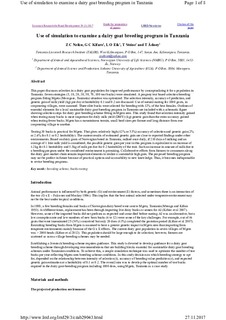| dc.description.abstract | This paper discusses selection in a dairy goat population for improved performance by conceptualizing it for a population in Tanzania. Seven strategies (5, 10, 20, 30, 50, 70, 100 test bucks) were simulated. A progeny test based selection breeding program fitting Mgeta (Morogoro, Tanzania) situation was optimized. The selection intensity, accuracy of prediction, and genetic gain of milk yield (kg) per day at heritability 0.1 and 0.2 are discussed. Use of natural mating for 1000 goats, in cooperating villages, were assumed. Three elite bucks were selected for breeding with 12% of the best females. Outlines of essential elements for a local sustainable dairy goat breeding program in Tanzania are included with a schematic figure showing selection steps for dairy goat breeding scheme fitting in Mgeta area. This study found that selection intensity gained when testing many bucks is more important for daily milk yield (DMY) (kg) genetic gain than the extra accuracy gained when testing fewer bucks. Mgeta has a mountainous terrain, small herd sizes per farmer and long distance from one cooperating village to another. Testing 30 bucks is practical for Mgeta. That gives relatively high (42% or 53%) accuracy of selection and genetic gain (2% or 2.6% for 0.1 or 0.2 heritability). The current results of estimated genetic gain are close to reported findings under other environments. Based on dairy goats of Norwegian breed in Tanzania, milked once daily, if 210 days of milking and an average of 1 litre milk yield is considered, the possible genetic gain per year in this program is equivalent to an increase of 4.2kg for 0.1 heritability and 5.5kg of milk per doe for 0.2 heritability of the trait. Such an increase in amount of milk due to a breeding program under the considered environment is promising. Collaborative efforts from farmers to consumers along the dairy goat market chain remain important elements to realize a sustainable high gain. The proposed breeding program may not be perfect in future because of practical options and accessibility to new knowledge. Thus, it becomes indispensable to revise breeding programs. | nb_NO |

